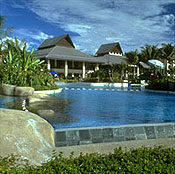KUNDASANG: Czech Republic's Anna Pichtrova proved her billing when she clinched her fourth consecutive title in the women's open of the 19th Mount Kinabalu International Climbathon yesterday (Saturday).
The 34 year-old ran way up and down the 21-kilometre-long race trail from start to finish with a time of 3:13.25s, some 15 minutes ahead of her nearest challenger Favre Corinne of France.
Corinne who is also crowned as the World Mountain Running Trophy champion clocked 3:29.08s to take the second spot. The climbathon serves as the final leg of the Buff Sky Runners World Series circuit.
In third spot was Venezuela national athlete Cruz Aleida Salazar with a time of 3:42.19s.
Pichtrova said the whole race was hard.
"I was doing better going uphill. Technically the race was tough on the downhill section but I just kept running," said 34- year-old Pichtrova.
Pichtrova bagged the top cash prize of US$4,500 with her effort and a gold pendent for being the first to reach the summit of Mt. Kinabalu with a time of 2:02.26s.
The four- time champion said, France's Favre Corinne was her toughest challenger in the event.
"I just dashed up the mountain and when I looked back she (Favre) was behind me," the Czech said, adding that it was fourth time luck that made her champion.
Pichtrova said the climbathon served as her last championship for this year. "Everything starts again next year with the marathon races being her opening races," she said, adding that next year she would return again to defend her title.
The weather yesterday proved to be on the runners' side. It was clear and bright throughout the race which began at 7am.
Corinne, meanwhile, said she's happy with her podium finish despite having to run all the up and down the 4,095.2 metre-summit with a headache and stomach pain.
"I was really tired and I felt horrible...my head and stomach were hurting me...but I just had to keep going," said the WMRT champion after the race. Corinne won US$4,000 for her effort.
Corinne, who is a sky instructor by profession, said that she had to go slow on the downward trip as the path was a bit slippery.
She revealed that last year she could not take part in the WMRT due to her busy schedule.
Favre with her second place finish was declared the world skyrunning champion having won the four previous legs in the circuit. She won in Dolomites, Italy; La Pagne, France; Colorado, US and Grigne, Italy.
Third place winner Cruz Aleida Salazar was stretchered to the medic's tent from the finish line after limping through half the downhill section. She clocked a time of 3:42.19s while in fourth place was Spain Roser Espanol Bada with a time of 3:44.46s.
Meanwhile in the men's veteran event, all local faces topped the three top spot with Kota Belud farmers Taising Bukolong, Jios Kundapit and Raimin Iki winning the RM1,000, RM800 and RM600 cash prizes respectively.
"I did not face any problem until I have reached the finishing line," Taising said, revealing that his feet felt sore and painful after running up and down the mountain.
"I only had one training session prior to the race. I was not afraid and this time the weather was perfect.
Taising said he would take part again next year.
The race, which is divided in three categories-men, women and veteran men-offers cash prizes totalling RM130,000.
A total of 44 participants started Saturday in the women's section and 46 in the veteran men.
Dubbed the world's toughest mountain race, the climbathon has a race distance of 21km for both men and women with an elevation from an altitude of 1,800m up to the peak at 4,095m and down the same trail.
The race is also accredited as the finale of the 2005 World Skyrunning Championship circuit under the Federation of Sports At Altitude. Prior to this six other circuit races were held in Spain, France, US, Italy (two locations) and Switzerland.
Courtesy of Daily Express



